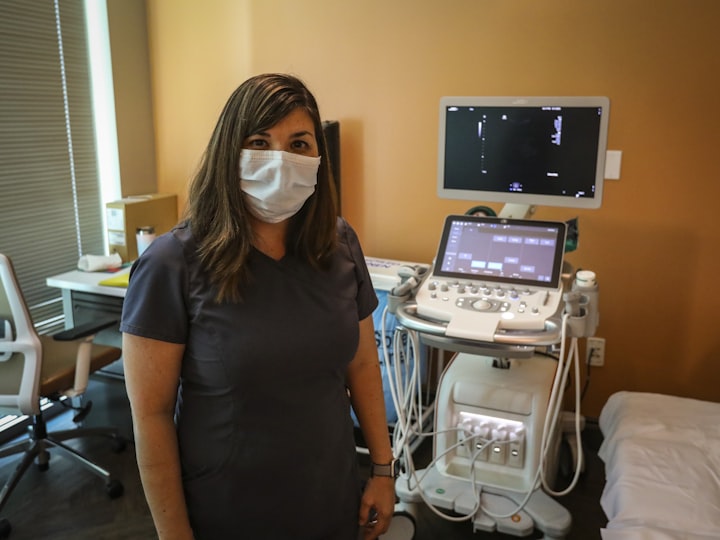The Potential Of Ultrasound In Identifying Polycystic Ovary Syndrome (PCOS)
- Christopher David Paul

Polycystic ovary syndrome (PCOS) is a common endocrine disorder affecting women of reproductive age. It is characterized by hormonal imbalances, irregular menstrual cycles, and the presence of multiple small cysts on the ovaries.
The diagnosis of PCOS traditionally relies on a combination of clinical symptoms, hormonal evaluations, and ultrasound imaging. In recent years, ultrasound technology has emerged as a valuable tool in the identification and evaluation of PCOS.
This article aims to explore the potential of ultrasound in detecting and diagnosing PCOS, as well as discussing its benefits, limitations, and future directions.
Moreover, ultrasound not only aids in the diagnosis of PCOS but also helps in monitoring the response to treatment and assessing the risk of complications associated with the condition.
By providing a non-invasive and real-time imaging modality, ultrasound offers a comprehensive evaluation of the ovaries, enabling healthcare professionals to make informed decisions regarding patient care and management strategies.
Understanding the potential of ultrasound in identifying PCOS is essential as it contributes to early detection and intervention, potentially preventing long-term complications such as infertility, insulin resistance, and cardiovascular disorders.
By delving into the benefits, limitations, and future directions of ultrasound in PCOS diagnosis, this article aims to shed light on the expanding role of ultrasound in improving the lives of women affected by this condition.
Ultrasound Imaging And PCOS:
Ultrasound imaging plays a vital role in the diagnosis of PCOS. It is a non-invasive, safe, and relatively affordable imaging modality that allows visualization of the ovaries and assessment of their structure.
Transvaginal ultrasound, performed with a probe inserted into the vagina, offers higher resolution and better visualization of the ovaries than transabdominal ultrasound.
It enables the identification of multiple small cysts, often referred to as "string of pearls," on the ovaries, one of the hallmark features of PCOS. The presence of these cysts, along with other diagnostic criteria such as irregular menstrual cycles and clinical symptoms, contributes to a conclusive diagnosis.
In addition to cysts, ultrasound can also evaluate other aspects associated with PCOS. It helps determine the size of the ovaries and the presence of follicles that may not have matured, which are commonly seen in PCOS.
The measurement of ovarian volume and the calculation of the ovarian stromal area using ultrasound have also been proposed as potential diagnostic markers for PCOS.
Furthermore, Doppler ultrasound can assess ovarian blood flow, providing additional insights into the pathophysiology of PCOS.
Ultrasound imaging offers a comprehensive evaluation of the ovaries in PCOS, providing valuable information beyond the identification of cysts. The assessment of ovarian size is important as PCOS is often associated with enlarged ovaries.
Ultrasound allows for precise measurements of ovarian volume, aiding in the characterization and monitoring of the condition.
Furthermore, ultrasound helps identify immature follicles, which are follicles that have not reached full maturation.
These follicles can be visualized as small, fluid-filled sacs on the ultrasound image. Their presence is a common finding in PCOS and contributes to the diagnostic criteria.
Ovarian stromal area, another parameter measured through ultrasound, refers to the area of tissue surrounding the follicles.
Research suggests that an increased ovarian stromal area may serve as a diagnostic marker for PCOS. By quantifying this area, ultrasound can provide additional evidence for the presence of PCOS.
Doppler ultrasound is a specialized technique that measures blood flow within the ovaries. It enables the assessment of ovarian perfusion and vascularization, offering insights into the pathophysiology of PCOS.
Abnormal blood flow patterns, such as increased vascularity, may be indicative of hormonal imbalances and contribute to the diagnosis and management of PCOS.
In summary, ultrasound imaging goes beyond the identification of cysts and plays a crucial role in evaluating various aspects associated with PCOS.
From assessing the ovarian size and follicle development to measuring the ovarian stromal area and evaluating blood flow, ultrasound provides a comprehensive picture of the ovarian characteristics in PCOS.
This multifaceted evaluation aids in accurate diagnosis and ongoing monitoring of the condition.
Benefits And Limitations Of Ultrasound In PCOS Diagnosis:
Ultrasound imaging offers several advantages in the diagnosis of PCOS. Ultrasound imaging is widely available, does not involve ionizing radiation, and is well-tolerated by patients.
Furthermore, ultrasound is an efficient technique for evaluating ovarian morphology, allowing for a comprehensive assessment of the size, shape, and structure of the ovaries.
It provides real-time imaging, enabling immediate visualization and interpretation of the results, which is particularly valuable in the clinical setting.
However, ultrasound has certain limitations when it comes to PCOS diagnosis. The subjective interpretation of ultrasound images may introduce interobserver variability, leading to inconsistencies in diagnosing PCOS.
The criteria for defining polycystic ovaries can vary among different medical societies and researchers, further complicating the interpretation. Moreover, not all women with PCOS exhibit the classic ovarian morphology seen on ultrasound, making it less reliable as a standalone diagnostic tool.
Clinical symptoms and hormonal evaluations remain crucial components of the diagnostic process.
Another significant benefit of ultrasound in PCOS diagnosis is its wide availability. Ultrasound machines are commonly found in healthcare facilities, making it accessible for patients in various settings.
Additionally, ultrasound is a non-invasive procedure that does not involve ionizing radiation, making it safe for repeated examinations, especially for women who may require ongoing monitoring or fertility treatments.
The real-time imaging capability of ultrasound is particularly advantageous in the clinical setting. It allows healthcare professionals to visualize and interpret the results immediately, facilitating prompt decision-making and patient management.
This real-time feedback can be especially helpful during procedures such as follicle tracking for assisted reproductive techniques.
However, there are limitations to consider when relying solely on ultrasound for PCOS diagnosis. The interpretation of ultrasound images is subjective and can vary among different observers.
This variability introduces the potential for inconsistencies in diagnosing PCOS, especially when different criteria are used to define polycystic ovaries.
Medical societies and researchers may have different thresholds for the number of cysts or specific measurement criteria, leading to discrepancies in diagnoses.
It is important to note that not all women with PCOS exhibit the classic ovarian morphology observed on ultrasound. Some individuals may have normal-appearing ovaries despite meeting other diagnostic criteria.
This discrepancy can lead to false-negative results, emphasizing the importance of a comprehensive approach that includes clinical symptoms and hormonal evaluations in addition to ultrasound findings.
While ultrasound is a valuable tool in PCOS diagnosis, it is most effective when used in conjunction with other diagnostic measures. Combining ultrasound findings with patient history, clinical symptoms, and hormone level assessments provides a more holistic approach to PCOS diagnosis, ensuring accurate identification and effective management strategies.
The integration of multiple modalities enhances diagnostic accuracy and helps healthcare professionals make informed decisions regarding patient care.
Future Directions And Advancements:
As we look towards the future, advancements in ultrasound technology continue to drive innovation in PCOS diagnosis. Three-dimensional (3D) ultrasound is an emerging technique that allows for more detailed visualization of the ovaries.
With 3D ultrasound, healthcare professionals can obtain volumetric data, enabling a comprehensive assessment of ovarian morphology. This advancement has the potential to provide a more accurate representation of the ovaries and enhance the diagnostic capabilities for PCOS.
Ultrasound elastography is another promising advancement in PCOS diagnosis. This technique measures tissue stiffness, offering insights into the structural changes associated with PCOS.
By assessing the stiffness of ovarian tissues, ultrasound elastography may contribute to a more objective evaluation of PCOS and aid in differentiating it from other conditions with similar clinical presentations.
Contrast-enhanced ultrasound (CEUS) is an area of active research in PCOS diagnosis. CEUS involves the use of contrast agents to enhance the visualization of blood flow within the ovaries.
By evaluating ovarian perfusion and microvascularization, CEUS may provide valuable information for distinguishing between different subtypes of PCOS and further elucidating the underlying mechanisms of the condition.
The integration of artificial intelligence (AI) and machine learning algorithms holds immense potential for PCOS diagnosis. Researchers are exploring the application of these technologies to automate the analysis and interpretation of ultrasound images.
By training algorithms on large datasets, AI can assist in the identification and quantification of specific features associated with PCOS. This can improve the objectivity and consistency of ultrasound assessments, potentially reducing interobserver variability and enhancing diagnostic accuracy.
Moreover, AI algorithms can aid in the development of predictive models, enabling early identification of PCOS or even predicting the risk of developing the condition in at-risk individuals.
By harnessing the power of AI, ultrasound imaging can be further optimized and personalized, ultimately improving diagnostic capabilities and patient outcomes in PCOS.
Conclusion:
Ultrasound imaging plays a crucial role in the diagnosis of PCOS by allowing visualization of the ovaries and identification of characteristic cysts.
It provides valuable information about ovarian morphology and can assist in assessing other features associated with PCOS. Despite its benefits, ultrasound has limitations and should be used in conjunction with clinical symptoms and hormonal evaluations for a comprehensive diagnosis.
Advancements in ultrasound technology, such as 3D ultrasound, ultrasound elastography, and CEUS, offer potential avenues for improving PCOS diagnosis.
Additionally, the application of AI and machine learning algorithms hold promise in enhancing the objectivity and accuracy of ultrasound assessments.
As the understanding of PCOS continues to evolve, ultrasound imaging remains an essential diagnostic tool in the identification and evaluation of this complex disorder.
With ongoing advancements and research, ultrasound has the potential to contribute further to the early detection and management of PCOS, ultimately improving the quality of life for women affected by this condition.
About the Creator
Christopher David
I am a writer, editor and an avid reader.





Comments (1)
For further information on this topic, I recommend reaching out to the experts at https://ris.com.au/. As one of the leading diagnostic imaging providers in Australia, they can provide valuable insights and expertise regarding PCOS diagnosis.